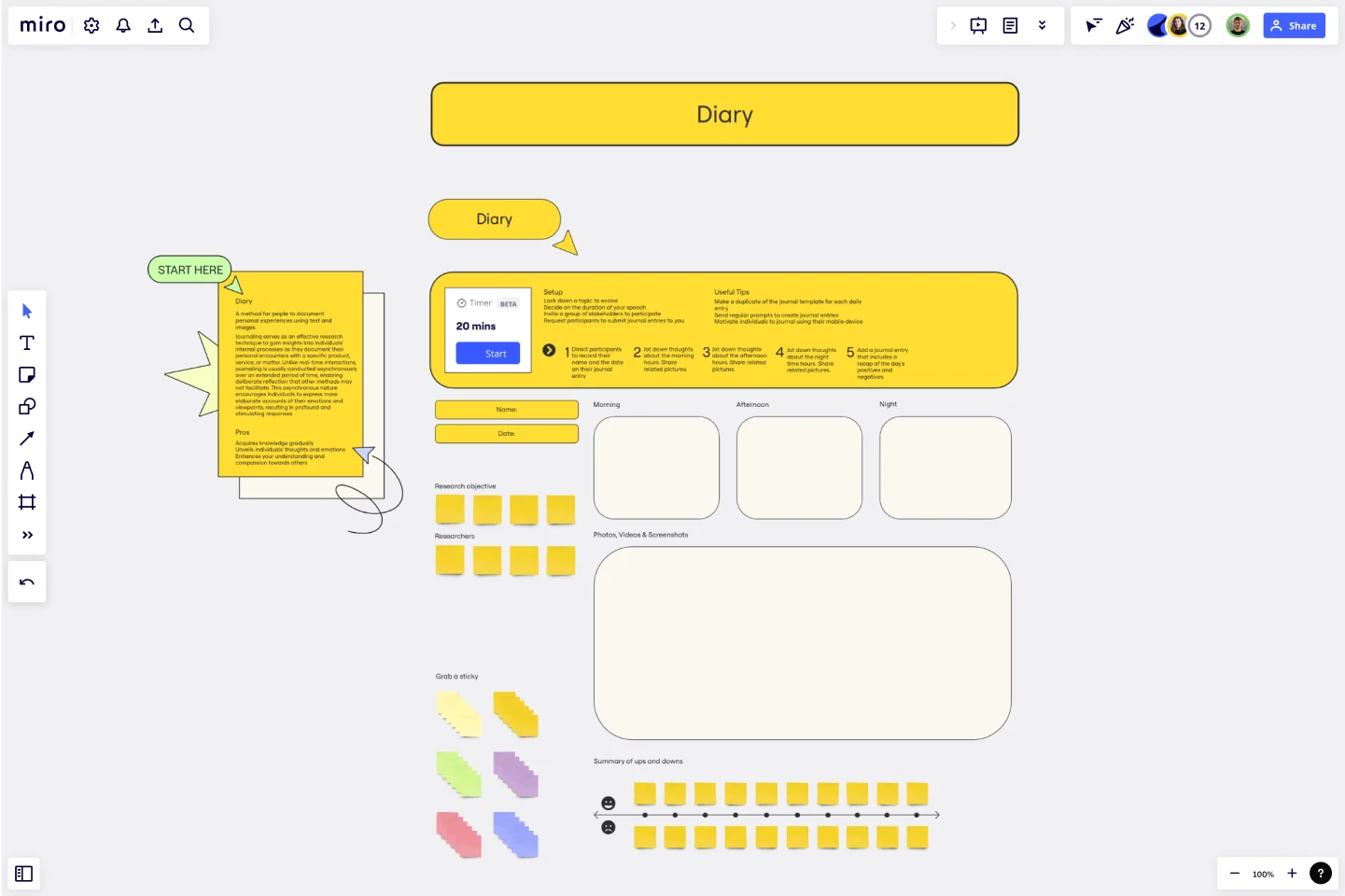Diary Template
Document personal experiences using text and images with the Diary Template.
About the Diary Template
The Diary Template is a valuable research tool for documenting experiences with a particular product, service, or subject over an extended period of time. It allows for a more thoughtful and deliberate reflection, enabling people to express emotions and viewpoints that may not have been conveyed in real-time interactions.
Journaling with the template provides a profound and in-depth understanding of people's internal processes that other research methods may not achieve. The reflective and introspective nature of journaling encourages people to share deep and insightful responses, resulting in a more comprehensive analysis of the subject being studied.
Benefits of using the template
Acquire knowledge gradually.
Unveil people's thoughts and emotions.
Enhance your understanding and compassion towards others.
How to use the template in Miro
Direct participants to record their name and the date on their journal entry
Jot down thoughts about the morning hours. Share related pictures.
Jot down thoughts about the afternoon hours. Share related pictures.
Jot down thoughts about the nighttime hours. Share related pictures.
Add a journal entry that includes a recap of the day's positives and negatives.
Setup
Lock down a topic to evolve.
Decide on the duration of your speech.
Invite a group of stakeholders to participate.
Request participants to submit journal entries to you.
Useful tips
Make a duplicate of the journal template for each daily entry.
Send regular prompts to create journal entries.
Motivate people to journal using their mobile devices.
Get started with this template right now.
Zoom Levels Template
The Zoom Level Template is a tool to examine a problem from various perspectives. For more innovative solutions, consider the issue broadly. Ascending the ladder enables you to broaden your perspective (ask, 'How might we?'). When confronted with an overly broad scope that hinders progress, descending the ladder helps narrow your focus (ask 'What if we narrowed?').
Product Development Roadmap Template
Works best for:
Product Management, Software Development
Product development roadmaps cover everything your team needs to achieve when delivering a product from concept to market launch. Your product development roadmap is also a team alignment tool that offers guidance and leadership to help your team focus on balancing product innovation and meeting your customer’s needs. Investing time in creating a roadmap focused on your product development phases helps your team communicate a vision to business leaders, designers, developers, project managers, marketers, and anyone else who influences meeting team goals.
Filmmakers Storyboard
Works best for:
Storyboard, Design, Planning
Bring your film projects to life with the Filmmakers Storyboard template. Designed for directors, producers, and cinematographers, this template helps you plan every aspect of your film, from scene composition to shot sequences. It includes detailed sections for visual elements, camera angles, and dialogue, ensuring a smooth production process. Use this template to create a clear visual guide that communicates your vision and enhances collaboration among your film crew.
Video Storyboarding Template
Videos can be a game-changer when presenting a new idea. To create an engaging video, structure your narrative effectively using a Video Storyboarding Template. This ensures your message is clear and easy to understand and can help you gain support and feedback.
How Might We Template
It's crucial to ask the right questions to find the best solutions. Skilled critical thinkers can uncover the underlying complexities of a problem instead of just accepting it at face value. One way to encourage this type of thinking is by using statement starters, such as the How Might We Template. These tools can help you explore more open-ended problems and have more productive discussions, ultimately leading to the most effective solutions.
Storyboards by maad labs
Works best for:
Storyboard, Planning, Design
Simplify your story creation process with Storyboards by maad labs. This template offers a user-friendly interface for mapping out your narrative projects, making it ideal for both beginners and seasoned professionals. It includes sections for scene descriptions, character notes, and dialogue, helping you to organize your ideas and present them clearly. Use this template to enhance your storytelling workflow and bring your creative visions to life with ease
